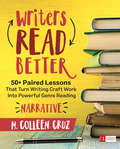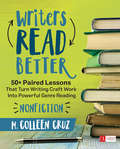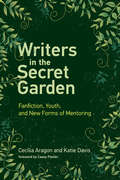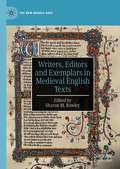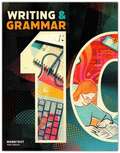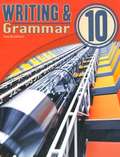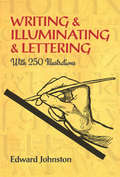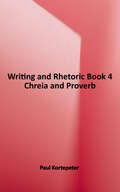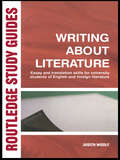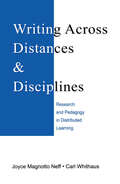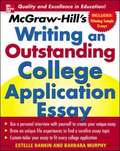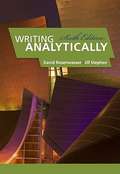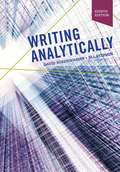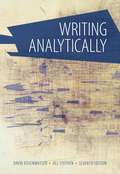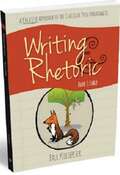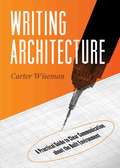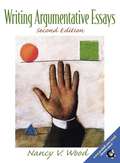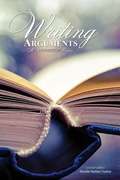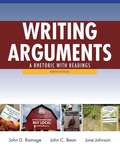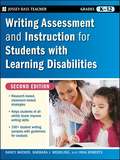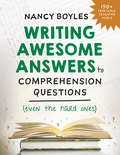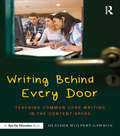- Table View
- List View
Writers Read Better: 50+ Paired Lessons That Turn Writing Craft Work Into Powerful Genre Reading (Corwin Literacy)
by M. Colleen CruzWhen It Comes to Reading, Writers Have an Advantage We know that writing skills reinforce reading skills, but what’s the best way to capitalize on this relationship? By flipping the traditional “reading lesson first, writing lesson second” sequence, Colleen Cruz helps you make the most of the writing-to-reading connection with 50 carefully matched lesson pairs centered around narrative texts. Lessons can be implemented either as a complete curriculum or as a supplement to an existing program. Complete with suggestions on adapting the lessons to suit the needs of your classroom and individual students, Writers Reader Better: Narrative offers a solid foundation for giving your students the advantage of transferable literacy skills.
Writers Read Better: 50+ Paired Lessons That Turn Writing Craft Work Into Powerful Genre Reading (Corwin Literacy)
by M. Colleen CruzWe know that writing skills reinforce reading skills, but what’s the best way to capitalize on this beneficial relationship? By flipping the traditional "reading lesson first, writing lesson second" sequence, Colleen Cruz ingeniously helps you make the most of the writing-to-reading connection with carefully matched, conceptually connected lesson pairs. The result is a healthy reciprocity that effectively and efficiently develops students’ literacy skills. Backed by long-term academic and field research, Writers Read Better presents a series of 50 tightly interconnected lesson pairs that can be implemented either as supplement existing curriculum or as a stand alone module. Each pairing leads with a writing lesson, used as a springboard for the reading lesson that will follow. Throughout the book’s four sections, organized to cover distinct and complementary phases of working with non-fiction texts, you’ll discover Helpful insights on preparing for the section’s overarching goals Clear guidance on the intention of each lesson, what materials are required, and step-by-step plans for leading the activity Sample teacher language for leading the lesson Tips on building and organizing your classroom library, and how you can incorporate the tools, technology and media available in your classroom to make each lesson most effective Sample student work, online videos and other supporting resources Complete with practical suggestions on adapting the lessons to suit the particular needs of your classroom as well as individual students, Writers Reader Better offers a solid foundation for giving your students the advantage of powerful, transferable literacy skills.
Writers Read Better: 50+ Paired Lessons That Turn Writing Craft Work Into Powerful Genre Reading (Corwin Literacy)
by M. Colleen CruzWe know that writing skills reinforce reading skills, but what’s the best way to capitalize on this beneficial relationship? By flipping the traditional "reading lesson first, writing lesson second" sequence, Colleen Cruz ingeniously helps you make the most of the writing-to-reading connection with carefully matched, conceptually connected lesson pairs. The result is a healthy reciprocity that effectively and efficiently develops students’ literacy skills. Backed by long-term academic and field research, Writers Read Better presents a series of 50 tightly interconnected lesson pairs that can be implemented either as supplement existing curriculum or as a stand alone module. Each pairing leads with a writing lesson, used as a springboard for the reading lesson that will follow. Throughout the book’s four sections, organized to cover distinct and complementary phases of working with non-fiction texts, you’ll discover Helpful insights on preparing for the section’s overarching goals Clear guidance on the intention of each lesson, what materials are required, and step-by-step plans for leading the activity Sample teacher language for leading the lesson Tips on building and organizing your classroom library, and how you can incorporate the tools, technology and media available in your classroom to make each lesson most effective Sample student work, online videos and other supporting resources Complete with practical suggestions on adapting the lessons to suit the particular needs of your classroom as well as individual students, Writers Reader Better offers a solid foundation for giving your students the advantage of powerful, transferable literacy skills.
Writers in the Secret Garden: Fanfiction, Youth, and New Forms of Mentoring (Learning in Large-Scale Environments)
by Katie Davis Cecilia AragonAn in-depth examination of the novel ways young people support and learn from each other though participation in online fanfiction communities.Over the past twenty years, amateur fanfiction writers have published an astonishing amount of fiction in online repositories. More than 1.5 million enthusiastic fanfiction writers—primarily young people in their teens and twenties—have contributed nearly seven million stories and more than 176 million reviews to a single online site, Fanfiction.net. In this book, Cecilia Aragon and Katie Davis provide an in-depth examination of fanfiction writers and fanfiction repositories, finding that these sites are not shallow agglomerations and regurgitations of pop culture but rather online spaces for sophisticated and informal learning. Through their participation in online fanfiction communities, young people find ways to support and learn from one another. Aragon and Davis term this novel system of interactive advice and instruction distributed mentoring, and describe its seven attributes, each of which is supported by an aspect of networked technologies: aggregation, accretion, acceleration, abundance, availability, asynchronicity, and affect. Employing an innovative combination of qualitative and quantitative analyses, they provide an in-depth ethnography, reporting on a nine-month study of three fanfiction sites, and offer a quantitative analysis of lexical diversity in the 61.5 billion words on the Fanfiction.net site. Going beyond fandom, Aragon and Davis consider how distributed mentoring could improve not only other online learning platforms but also formal writing instruction in schools.
Writers, Editors and Exemplars in Medieval English Texts (The New Middle Ages)
by Sharon M. RowleyThis collection of essays explores the literary legacy of medieval England by examining the writers, editors and exemplars of medieval English texts. In order to better understand the human agency, creativity and forms of sanctity of medieval England, these essays investigate both the production of medieval texts and the people whose hands and minds created, altered and/or published them. The chapters consider the writings of major authors such as Chaucer, Gower and Wyclif in relation to texts, authors and ideals less well-known today, and in light of the translation and interpretive reproduction of the Bible in Middle English. The essays make some texts available for the first time in print, and examine the roles of historical scholars in the construction of medieval English literature and textual cultures. By doing so, this collection investigates what it means to recover, study and represent some of the key medieval English texts that continue to influence us today.
Writing & Grammar Grade 10 Student Text (Fourth Edition)
by Bob Jones UniversityThis updated fourth edition of BJU Press' Writing and Grammar, Grade 10 student text features full-color pages with historical examples and context from all eras. Charts, sample sentences, enrichment focusing on thinking skills and Bible letters, and ESL notes all provide additional insights and interest to the chapter's primary focus. Lessons feature an excerpt, grammar exercises, and writing activities. This grade 10 text covers parts of speech, sentences, phrases, clauses, agreement, verb use, pronoun reference, capitalization, punctuation, writing, library skills, study skills, and more.
Writing & Illuminating & Lettering: With 250 Illustrations
by Edward JohnstonOne of the founders of modern calligraphy, Edward Johnston regarded lettering, writing, and illuminating as not only desirable ends in themselves but also as practical avenues to mastery of typography, decoration, and design. In this classic, profusely illustrated guide, he distilled his expertise into a series of easy-to-follow lessons that will benefit any student of calligraphy, book design, or art.Part I is devoted to writing and illuminating. Early chapters cover the fundamentals of acquiring a formal hand: choosing paper, ink, and quills; holding the pen; spacing and planning a manuscript; and more. The author then turns to the techniques of producing a manuscript book: tools and materials, methods and proportions, margins, and other methods. Part II offers a detailed discussion of lettering: the qualities of good lettering, methods of construction and arrangement, spacing, proportion, and other matters. Two appendixes cover the uses of lettering in book bindings, wall inscriptions, monograms, and title pages as well as the techniques involved in lettering on metal, wood, and stone.
Writing & Rhetoric Book 4: Chreia & Proverb
by Paul KortepeterThe Writing and Rhetoric series method employs fluent reading, careful listening, models for imitation, and progressive steps. It assumes that students learn best by reading excellent, whole-story examples of literature and by growing their skills through imitation. Each exercise is intended to impart a skill (or tool) that can be employed in all kinds of writing and speaking. The exercises are arranged from simple to more complex. What's more, the exercises are cumulative, meaning that later exercises incorporate the skills acquired in preceding exercises. This series is a step-by-step apprenticeship in the art of writing and rhetoric.
Writing AI Prompts For Dummies
by Stephanie Diamond Jeffrey AllanLearn the art of writing effective AI prompts and break into an exciting new career field Unlock the full power of generative AI with Writing AI Prompts For Dummies, a comprehensive guide that will teach you how to confidentially write effective AI prompts. Whether it's text, images, or even videos and music you're aiming to create, this book provides the foundational knowledge and practical strategies needed to produce impressive results. Embark on a journey of discovery with Writing AI Prompts For Dummies and learn how to: Craft AI prompts that produce the most powerful results. Navigate the complexities of different AI platforms with ease. Generate a diverse range of content, from compelling narratives to stunning visuals. Refine AI-generated output to perfection and integrate that output effectively into your business or project. This resource is brimming with expert guidance and will help you write AI prompts that achieve your objectives. Whether you're a marketer, educator, artist, or entrepreneur, Writing AI Prompts For Dummies is your indispensable guide for leveraging AI to its fullest potential. Get ready to harness the power of artificial intelligence and spark a revolution in your creative and professional efforts.
Writing About Literature: Essay and Translation Skills for University Students of English and Foreign Literature
by Judith WoolfWriting about Literature combines detailed practical and scholarly advice with a sense of the scope and creative possibilities of literary criticism, empowering the student reader to make his or her own discoveries and experiments with language. In addition, it gives valuable guidance on adult language learning and translation skills for students of foreign literature. This handy, accessible guide covers all aspects of the essay-writing process, including: preliminary reading and choosing and researching a topic referencing and presentation computer use style, structure, vocabulary, grammar and spelling the art and craft of writing scholarly and personal insights into the problems and pleasures of writing about literature. Written in an entertaining and informative way and containing a wealth of practical advice and scholarly insights, this wise, witty and helpful book should be on every literature student's bookshelf.
Writing Across Distances and Disciplines: Research and Pedagogy in Distributed Learning
by Joyce Magnotto Neff Carl WhithausWriting Across Distances and Disciplines addresses questions that cross borders between onsite, hybrid, and distributed learning environments, between higher education and the workplace, and between distance education and composition pedagogy. This groundbreaking volume raises critical issues, clarifies key terms, reviews history and theory, analyzes current research, reconsiders pedagogy, explores specific applications of WAC and WID in distributed environments, and considers what business and education might teach one another about writing and learning. Exploring the intersection of writing across the curriculum, composition studies, and distance learning , it provides an in-depth look at issues of importance to students, faculty, and administrators regarding the technological future of writing and learning in higher education.
Writing An Outstanding College Application Essay
by Estelle Rankin Barbara MurphyFrom the creators of the popular 5 Steps to a 5 program, expert tips on writing college application essays In McGraw-Hill's Writing an Outstanding College Application Essay, two writing coaches show you how to craft an essay that will get you into the top college of your choice. Estelle Rankin and Barbara Murphy's hands-on instruction helps you plan and write well-constructed, engaging college application essays that really hold admissions officers' attention. They nurture an understanding of good writing and teach you to find your voice as a writer. Features include: Using personal interviews to create unique essays Planning and writing the first draft Mining life experiences for topics Tweaking the essay to fit different college applications Samples of winning student essays
Writing Analytically (6th Edition)
by David Rosenwasser Jill StephenRosenwasser and Stephen (Muhlenberg College, Allentown, PA) show undergraduate students in first-year writing courses, as well as those in more advanced writing-intensive courses in various subjects, how to learn to analyze information and use writing to discover and develop ideas. They explain how to become more observant and push observations to implications and conclusions; use evidence, evolve claims, and converse with sources to write analytical papers; and understand organization, disciplinary formats, introductions and conclusions, and grammar and style. Writing exercises that can be applied to print and visual, text-based, and experiential materials are included, as are tips from professors on differences in disciplines other than English, rhetoric, or composition. This edition has a new introductory chapter previewing key topics, more examples, and more lists and rationales. It has two toolkit chapters on analytical methods instead of one, some reorganization and reformatting, more description of discipline-specific writing (especially the natural and social sciences), and new material in chapters on form. It has new sections on Rogerian argument, practical reasoning, and figurative logic, and expanded treatment of the four documentation styles. It clarifies step-by-step instructions, uncovering assumptions, and the method of looking for patterns of repetition and contrast. Another edition of the book includes readings. Annotation ©2012 Book News, Inc. , Portland, OR (booknews. com)
Writing Analytically (8th Edition)
by David Rosenwasser Jill StephenWRITING ANALYTICALLY treats writing as a tool of thought, offering prompts that lead students through the process of analysis and help them to generate original, well-developed ideas. The authors of this brief, popular rhetoric believe that learning to write well requires learning to use writing as a tool to think well. Rosenwasser and Stephen emphasize analysis as a mode of enriching understanding that precedes and in some cases supplants argument. Materials in the eighth edition are better integrated, more contextualized and--when possible--condensed. A new chapter, Thinking Like a Writer, contains a broad array of strategies for integrating opportunities for writing into a course. It makes explicit a subtext that pervades the book: that to think of yourself as a writer is to see more, to think differently and to engage the meaning of things more earnestly.
Writing Analytically, Seventh Edition
by David Rosenwasser Jill StephenWriting Analytically treats writing as a tool of thought, offering prompts that lead you through the process of analysis and synthesis and help you to generate original, well-developed ideas.
Writing And Rhetoric Book 1: Student
by Paul KortepeterA Creative Approach to the Classical Progymnasmata- Think of the progymnasmata as a step-by-step apprenticeship in the art of writing and rhetoric. What is an apprentice? It is a young person who is learning a skill from a master teacher. Our students will serve as apprentices to the great writers and great stories of history. Students are often expected to write with no clear model before them.Modern composition scolds traditional writing instruction as rote and unimaginative.It takes imitation to task for a lack of freedom and personal expression.And yet, effective communication from writer to reader always requires some sort of form and structure.Many of historys greatest writers learned by imitation.In other words, writing takes the same kind of determined study as ballet or diving.Creativity uses conventional form as a stage or a springboard from which to launch grand jetes and somersaults. Too often students are expected to tackle complex writing assignments without learning the necessary intermediate steps.The assumption is that because most everyone can speak English well enough to be understood, and form letters with a pencil, that everyone should be able to write well.Yet how many of us would expect a child to sit at a piano, without piano lessons, and play a concerto?Writing is never automatic. The Writing & Rhetoric seriesmethod employsfluent reading, careful listening, models for imitation, and progressive steps.It assumes that students learn best by reading excellent, whole-story examples of literature and by growing their skills through imitation. Each exercise is intended to impart a skill (or tool) that can be employed in all kinds of writing and speaking.The exercises are arranged from simple to more complex. Whats more, the exercises are cumulative, meaning that later exercises incorporate the skills acquired in preceding exercises.This series is a step-by-step apprenticeship in the art of writing and rhetoric. Fable, the first book in the Writing & Rhetoric series, teaches students the practice of close reading and comprehension, summarizing a story aloud and in writing, and amplification of a story through description and dialogue.Students learn how to identify different kinds of stories;determine the beginning, middle, and end of stories;recognize point of view; and see analogous situations, among other essential tools. The Writing & Rhetoric seriesrecovers aproven method of teaching writing, using fables to teach beginning writers the craft of writing well.This is the first in a series of twelve books that will train students over six years, starting in grades three or four and up.
Writing Architecture
by Carter WisemanFor ages, architects have been criticized for speaking an insular language, known to some as "archispeak." Writing Architecture considers the process, methods, and value of architecture writing based on Carter Wiseman's 30 years of personal experience in writing, editing, and teaching in young architects how to write. This book creatively tackles a problematic issue that Wiseman considers to be a crucial characteristic of successful architecture writing: clarity of thinking and expression. He argues that because we live our lives within the built environment, architecture is the most comprehensive and complex of all art forms. Even brilliantly inspired and complex architectural structures would only amount to misunderstood abstractions without the support and reinforcement of the clear explanation.Written as a primer for both college level students and practitioners, Writing Architecture acknowledges and explores the boundaries between different techniques of architecture writing from myriad perspectives and purposes. A poetic description of the beauty and impact of a bridge will not illuminate the mechanical knowledge housed in the structure, but at the same time, dense architectural theory will not encourage individuals experiencing and supporting the bridge to perceive significance and usefulness in the design. Using excerpts and from writers in different genres and from different historical periods, Wiseman offers a unique and authoritative perspective on comprehensible writing skills needed for success.
Writing Architecture
by Carter WisemanFor ages, architects have been criticized for speaking an insular language, known to some as "archispeak." Writing Architecture considers the process, methods, and value of architecture writing based on Carter Wiseman's 30 years of personal experience in writing, editing, and teaching in young architects how to write. This book creatively tackles a problematic issue that Wiseman considers to be a crucial characteristic of successful architecture writing: clarity of thinking and expression. He argues that because we live our lives within the built environment, architecture is the most comprehensive and complex of all art forms. Even brilliantly inspired and complex architectural structures would only amount to misunderstood abstractions without the support and reinforcement of the clear explanation.Written as a primer for both college level students and practitioners, Writing Architecture acknowledges and explores the boundaries between different techniques of architecture writing from myriad perspectives and purposes. A poetic description of the beauty and impact of a bridge will not illuminate the mechanical knowledge housed in the structure, but at the same time, dense architectural theory will not encourage individuals experiencing and supporting the bridge to perceive significance and usefulness in the design. Using excerpts and from writers in different genres and from different historical periods, Wiseman offers a unique and authoritative perspective on comprehensible writing skills needed for success.
Writing Argumentative Essays (Second Edition)
by Nancy V. WoodThis unique rhetoric/reader helps readers develop strategies for critical reading, critical thinking, research, and writing that will help them argue clearly and convincingly in all types of argument. It shows how to identify and develop arguments, read and form reactions and opinions, analyze an audience, seek common ground, and use a wide, realistic range of techniques to write argument papers that express their individual views and original perspectives on modern issues. <P><P> Includes clear explanations and examples of argument theory and reading and writing processes, research and documentation skills, and offers a variety of writing activities for developing the exploratory paper, position paper, researched position paper, and the Rogerian argument paper. Unique chapters discuss argument styles (including cross-gender and cross-cultural communication styles), Rogerian argument, and argument and literature. 49 Essays for Analysis (several in each chapter) cover several broad issue areas and sub-issues concerning families, education, crime and the treatment of criminals, computers, race and culture in America, genetic engineering, and social responsibility.
Writing Arguments: A Rhetoric And Reader
by Brenda Herbert HarkerA reading companion for both the teachers and the students as they pursue the argumentative writing course; equipped with essays with different styles selected for viewpoint and meaning.
Writing Arguments: A Rhetoric with Readings, Ninth Edition
by John D. Ramage June Johnson John C BeanThe market-leading guide to arguments, Writing Arguments ,9/e has proven highly successful in teaching readers to read arguments critically and to produce effective arguments of their own.
Writing Assessment and Instruction for Students with Learning Disabilities
by Nancy Mather Barbara J. Wendling Rhia RobertsIt Contains strategies for working with all students that struggle with writing, Offers classroom-tested strategies, helpful information, 100+writing samples with guidelines for analysis, and handy progress-monitoring charts, Includes ideas for motivating reluctant writers, Mather is an expert in the field of learning disabilities.
Writing Awesome Answers to Comprehension Questions (Even the Hard Ones)
by Nancy BoylesHelp students appreciate texts and write about them with conviction. Responding to a comprehension question is a surprisingly complex task. It draws on multiple skills: students must be able to read and analyze a text passage; consider what aspect of the text the question addresses; and then quickly and concisely write about their ideas, citing evidence to support them. Hence the prominence of constructed-response questions in standardized testing. In this refreshingly clear and upbeat guide, literacy consultant Nancy Boyles gives a step-by-step demonstration of how to help students achieve success with this task—and in the process of unpacking the steps involved, demonstrates how the instruction can inspire teachers’ creativity as well as deepen students’ literacy skills. Filled with ready-to-use scaffolds for every stage of instruction—sets of sample questions, anchor charts, cue cards, answer frames—this is a one-stop resource for teaching students how to organize their thoughts about what they’ve read, and then set them down in writing.
Writing Behind Every Door: Teaching Common Core Writing in the Content Areas
by Heather Wolpert-GawronFor students to become college-ready writers, they must be exposed to writing throughout the school day, not just in English class. This practical book shows teachers in all subject areas how to meet the Common Core State Standards and make writing come alive in the classroom. Award-winning educator Heather Wolpert-Gawron provides effective and exciting ideas for teaching argument writing, informational writing, project-based writing, and writing with technology. Each chapter is filled with strategies, prompts, and rubrics you can use immediately. Special Features: A variety of writing strategies that work in any subject area Tips for developing meaningful prompts Diagrams and templates that you can use with your students Rubrics for assessing writing, as well as ideas for having students create their own rubrics Samples of student work in different formats Ideas for teaching students to break the Google homepage habit and conduct effective research Cross-curricular writing assignments for science, history, ELA, electives, and PE Suggestions for teaching summary writing, an essential academic skill Ideas for staff professional development on Common Core writing
